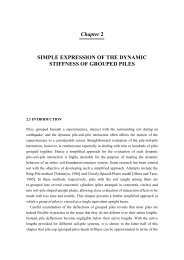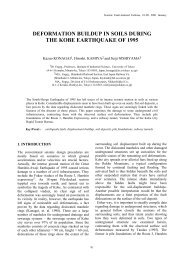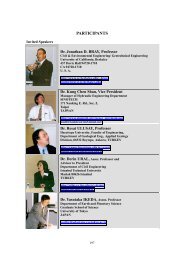Damage of Bridges Resulting from Surface Rupture of Faults in the ...
Damage of Bridges Resulting from Surface Rupture of Faults in the ...
Damage of Bridges Resulting from Surface Rupture of Faults in the ...
Create successful ePaper yourself
Turn your PDF publications into a flip-book with our unique Google optimized e-Paper software.
North Side<br />
South Side<br />
Root 3<br />
N60E<br />
<br />
Tatu Hsi<br />
N8-13E<br />
<br />
Wu-Shi Bridge<br />
<br />
N7W<br />
<br />
0<br />
300m<br />
<br />
Taiwan Geological Survay<br />
Not Confirmed<br />
K. Otsuki (Tohoku University)<br />
Kawashima, Shoji and Iwata<br />
Fig.24 Fault around Wu-Shi Bridge<br />
<br />
<br />
Photo 19 Lateral Movement <strong>of</strong> P1 and P2, Wu-Shi Bridge<br />
<br />
<br />
Fig.23 Failure <strong>of</strong> Piers, Wu-Shi Bridge<br />
contributed to absorb <strong>the</strong> large fault displacement,<br />
<strong>the</strong> decks (D1W and D2W) did not collapse.<br />
In a similar way, D1E and D2E <strong>in</strong> <strong>the</strong> northbound<br />
bridge were subjected to a large lateral force, which<br />
resulted <strong>in</strong> some damage at P1E and P2E. S<strong>in</strong>ce<br />
strength <strong>of</strong> wall piers (P1E and P2E) was large<br />
enough, <strong>the</strong>y did not collapse. However, this<br />
developed <strong>the</strong> large relative displacements between<br />
<strong>the</strong> piers and <strong>the</strong> decks, and this resulted <strong>in</strong> <strong>the</strong><br />
collapse <strong>of</strong> D1E and D2E.<br />
It appeared that <strong>the</strong> failure <strong>of</strong> <strong>the</strong> caisson<br />
foundation at P3W (refer to Photo 14) was<br />
developed by a direct fault movement.<br />
187






